Weaver Wednesday [70]: Madagascar Fody (Red Fody) 2013-10-15 (432)
 Weaver Wednesday
Weaver Wednesday
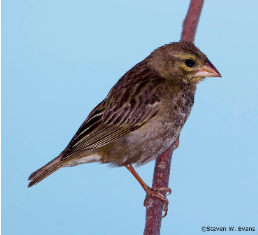
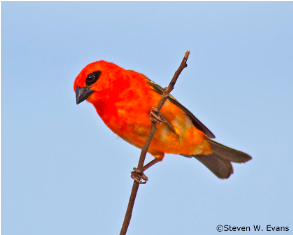
The Madagascar (or Red) Fody Foudia madagascariensis is abundant in Madagascar, and has been introduced to many other islands. The breeding male is crimson-red, with a short black line through the eye. There is notable variation in the red plumage, with some individuals more orange-coloured, or yellowish, and the brightness of the breast plumage is positively correlated with the male's body condition. The female and non-breeding male are olive-brown, with faint streaking. The juvenile resembles the female, but may be quite buffy. A fody with entirely red underparts must be a Madagascar Fody, but moulting fodies may be difficult to identify.
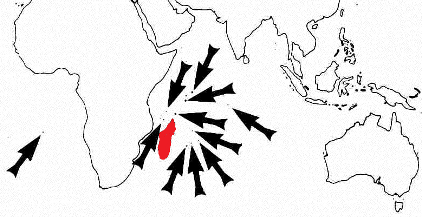 The Madagascar Fody occurs naturally in Madagascar (see red on map left). It has been introduced on Reunion, Mauritius, Seychelles, Rodrigues, Amirantes and Chagos Is, in the Indian Ocean, and also on St Helena in the Atlantic Ocean (see black arrows on map, based on Long JL, 1981, Introduced birds of the world). It has recently been found breeding in Oman and Bahrain. It is also present on Glorieuses and Comoro Islands, which it may have colonized without human assistance. No subspecies are recognised. Successful colonization of islands is thought to be a consequence mainly of its ability to breed successfully in the presence of black rats Rattus rattus.
The Madagascar Fody occurs naturally in Madagascar (see red on map left). It has been introduced on Reunion, Mauritius, Seychelles, Rodrigues, Amirantes and Chagos Is, in the Indian Ocean, and also on St Helena in the Atlantic Ocean (see black arrows on map, based on Long JL, 1981, Introduced birds of the world). It has recently been found breeding in Oman and Bahrain. It is also present on Glorieuses and Comoro Islands, which it may have colonized without human assistance. No subspecies are recognised. Successful colonization of islands is thought to be a consequence mainly of its ability to breed successfully in the presence of black rats Rattus rattus.
The Madagascar Fody inhabits open country, including natural savanna, cultivated areas and towns, and clearings in forest. It is not found in intact forest in Madagascar (except in transit), but forages in forest on Rodrigues Island. Roost-sites include sugar cane, bamboos, tall grasses, reedbeds, and mangroves and other trees. They show well-synchronized entry into and departure from large roosts (read more here).
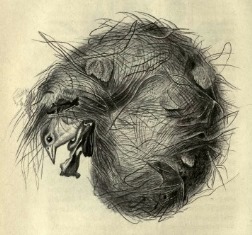 The Madagascar Fody feeds mainly on seeds; and also on nectar and arthropods. Seeds include those of grasses and rice, both when ripe and when in the milky stage. Arthropods include beetles, caterpillars and moths, and spiders. Nectar is taken from both native and exotic plants; birds often pull out parts of flowers to remove nectar from the base. Nestlings are fed on both seeds and insects. It often occurs in flocks, sometimes of hundreds of individuals, when feeding on seeds and is considered a serious pest in rice-growing areas. As a result, villagers trap and scare birds from fields and destroy nests.
The Madagascar Fody feeds mainly on seeds; and also on nectar and arthropods. Seeds include those of grasses and rice, both when ripe and when in the milky stage. Arthropods include beetles, caterpillars and moths, and spiders. Nectar is taken from both native and exotic plants; birds often pull out parts of flowers to remove nectar from the base. Nestlings are fed on both seeds and insects. It often occurs in flocks, sometimes of hundreds of individuals, when feeding on seeds and is considered a serious pest in rice-growing areas. As a result, villagers trap and scare birds from fields and destroy nests.
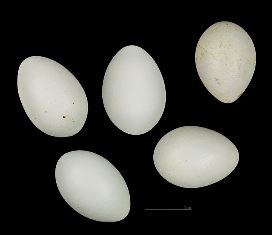 The Madagascar Fody is monogamous and probably double-brooded. It is not colonial, but at high density of birds the nests may be close together. The male defends his territory by singing from a prominent perches. The nest is oval, with a side entrance near the top. The entrance is under a projecting porch, and is sometimes extended into a short tunnel. The nest is woven mainly by the male, using grass strips. The nest has been considered one of the most primitive of the nests of the true weavers. Nests are attached to reeds, tall grass, branches of shrubs or trees. Nests not accepted by females may be abandoned or dismantled. The clutch is 2-4 eggs, and the eggs are pale blue-green, slightly glossy. The female incubates, but chicks are fed by both sexes, primarily by regurgitation.
The Madagascar Fody is monogamous and probably double-brooded. It is not colonial, but at high density of birds the nests may be close together. The male defends his territory by singing from a prominent perches. The nest is oval, with a side entrance near the top. The entrance is under a projecting porch, and is sometimes extended into a short tunnel. The nest is woven mainly by the male, using grass strips. The nest has been considered one of the most primitive of the nests of the true weavers. Nests are attached to reeds, tall grass, branches of shrubs or trees. Nests not accepted by females may be abandoned or dismantled. The clutch is 2-4 eggs, and the eggs are pale blue-green, slightly glossy. The female incubates, but chicks are fed by both sexes, primarily by regurgitation.
The Madagascar Fody has no PHOWN records of this common species (see PHOWN summary) and many more are needed. Old nests may be taken over by the Madagascar Bibfinch Lepidopygia nana, and these records can be submitted too! Submit any weaver nest records to PHOWN (PHOtos of Weaver Nests) via the Virtual Museum upload site.
PHOWN summary
Previous Wedn: Heuglin's Masked Weaver
Full weaver species list
|


 Weaver Watch
Weaver Watch


